
Val de Loire Wineries & Wines Stats
Wineries
124
Wines
1083
Val de Loire: A Cultural and Viticultural Legacy of French Wine
Introduction: Val de Loire, situated in the north-central part of France, is a captivating wine region that boasts a rich cultural heritage intertwined with its vineyards. The area, which includes parts of several departments, is not typically associated with one distinct wine style but rather showcases an extensive array of grape varieties and diverse winemaking traditions.
Region Overview: Val de Loire, translating to "Valley of the Loire," is renowned for its historical significance and natural beauty, with the Loire River flowing gently through the region. The UNESCO World Heritage Site, the "Loop" or "Val de Loire," includes over 1,000 kilometers (620 miles) of this magnificent river and its surroundings.
Region Wine Style: Val de Loire is an eclectic wine region with a diverse range of wines reflecting its unique terroirs, grape varieties, and winemaking traditions. Although it doesn't possess a single defining wine style, the region is recognized for its crisp, elegant white wines made primarily from Chenin Blanc, as well as light-bodied reds derived from Cabernet Franc and Gamay.
Grapes: The region is home to an impressive collection of grape varieties, with some of the most commonly planted including:
1. Chenin Blanc - This versatile grape is responsible for producing the white wines of Val de Loire, ranging from dry and minerally to sweet and honeyed styles like Vouvray Sec and Vouvray Moelleux. 2. Cabernet Franc - Known locally as Breton, this grape variety is the basis for the red wines of Chinon, Bourgueil, and St-Nicolas de Bourgeuil, among others. These wines exhibit subtle aromatics, soft tannins, and are often aged in oak barrels. 3. Gamay - While most famously associated with Beaujolais, this grape is also grown in certain areas of Val de Loire, like Saumur and Anjou, to produce light-bodied red wines with bright fruit flavors. 4. Pineau d'Aunis - A lesser-known grape variety native to the region, it contributes to unique, light-bodied red and rosé wines. 5. Other grapes like Cabernet Sauvignon, Côt (Malbec), and Chardonnay are also grown in smaller quantities.
Pairs with Foods: Val de Loire wines offer excellent versatility when it comes to pairing with various culinary creations. Some recommended food matches include:
1. Seafood - The region's crisp, white Chenin Blanc wines complement a wide range of seafood dishes, from oysters and mussels to grilled fish and shellfish. 2. Poultry - The light-bodied reds made from Cabernet Franc are an ideal match for roasted chicken and other poultry dishes. 3. Cheese - Val de Loire wines, particularly those made from Chenin Blanc, are excellent companions to a wide variety of cheeses, especially those with nutty, savory, or sweet flavors. 4. Charcuterie - The region's red wines, such as Chinon and Bourgueil, pair well with cured meats and pâtés. 5. Vegetarian dishes - Val de Loire wines are also well-suited to a variety of vegetarian dishes, from salads and pastas to grilled vegetables and ratatouille.
Conclusion: Val de Loire is a cultural gem in the world of wine, with its historical significance, natural beauty, diverse grape varieties, and adaptable wine styles that cater to various palates. Whether you're in pursuit of crisp whites or light-bodied reds, the region's wines are sure to captivate your senses and leave you with unforgettable memories.
Great things nearby when you are in Val de Loire
Vineyard 🍷
Coeur du Loup Vins -Domaine de Guette LoupGreat place to visit!
Val de Loire
France
Vivino: 3.8
